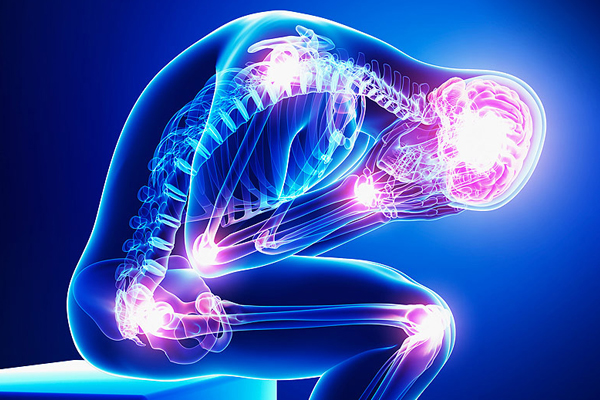Chronic Pain Management

Chronic Pain Management
What is Chronic Pain?
Chronic pain is defined as pain that persists for 12 weeks or more, even after the initial injury or cause of discomfort has healed. It can stem from an underlying medical condition, injury, or occur without a clear cause. Unlike acute pain, which signals immediate harm to the body, chronic pain can last for months or even years, affecting physical, emotional, and mental well-being.
Types of Chronic Pain
Chronic pain can manifest in various forms, including:
- Musculoskeletal Pain: Pain affecting muscles, joints, bones, and tendons. Common examples include osteoarthritis, rheumatoid arthritis, and fibromyalgia.
- Neuropathic Pain: Caused by nerve damage or dysfunction, leading to sharp, burning, or shooting pain. Conditions like diabetic neuropathy, sciatica, and postherpetic neuralgia fall under this category.
- Headaches: Chronic migraines or tension headaches can lead to persistent pain that impacts daily life.
- Lower Back Pain: One of the most common forms of chronic pain, often caused by injuries, degenerative disc disease, or muscle strain.
- Cancer-Related Pain: Can result from the disease itself or its treatment, such as chemotherapy or radiation.
Impact of Chronic Pain
Chronic pain affects more than just the physical body. It can disrupt sleep, reduce mobility, and lead to emotional challenges such as anxiety, depression, and feelings of hopelessness. Managing chronic pain requires a holistic approach that addresses both the physical and psychological aspects of pain.
Effective chronic pain management involves a combination of therapies tailored to the individual’s specific needs. Treatment may include medications, physical therapy, lifestyle changes, and alternative therapies aimed at improving quality of life and reducing pain.
Approaches to Chronic Pain Management
1. Medications
- Nonsteroidal Anti-Inflammatory Drugs (NSAIDs): Medications such as ibuprofen or naproxen can reduce inflammation and alleviate mild to moderate pain.
- Analgesics: Over-the-counter medications like acetaminophen provide pain relief without affecting inflammation.
- Opioids: Stronger pain medications, such as morphine or oxycodone, may be prescribed for severe pain, though they are generally used with caution due to the risk of dependency.
- Antidepressants and Anticonvulsants: These medications can be effective for certain types of neuropathic pain by affecting how the brain processes pain signals.
- Topical Treatments: Creams, gels, or patches containing lidocaine or capsaicin can be applied directly to the skin to numb localized pain.
2. Physical Therapy
Physical therapy plays a crucial role in chronic pain management by improving strength, flexibility, and mobility. A physical therapist can develop a personalized exercise program to reduce stiffness, build endurance, and correct posture, all of which can alleviate pain over time. Techniques used in physical therapy may include:
- Stretching and Strengthening Exercises: Target muscles and joints to improve range of motion and reduce tension.
- Heat and Cold Therapy: Helps reduce inflammation, relax muscles, and improve circulation to affected areas.
- Massage Therapy: Promotes relaxation, reduces muscle tension, and enhances blood flow to relieve pain.
3. Cognitive Behavioral Therapy (CBT)
Chronic pain often affects mental health, leading to stress, anxiety, or depression. Cognitive Behavioral Therapy (CBT) helps patients identify negative thought patterns and replace them with healthier coping mechanisms. CBT encourages a positive mindset toward pain management and teaches relaxation techniques, such as deep breathing and meditation, to manage pain levels.
4. Lifestyle Modifications
- Exercise: Regular physical activity can help manage chronic pain by improving blood flow, releasing endorphins, and reducing stiffness. Low-impact exercises such as swimming, yoga, or walking can be beneficial.
- Diet and Nutrition: A balanced diet rich in anti-inflammatory foods such as fruits, vegetables, whole grains, and omega-3 fatty acids may help reduce pain and inflammation. Maintaining a healthy weight also reduces pressure on joints and muscles, alleviating pain.
- Sleep Hygiene: Chronic pain often disrupts sleep, but establishing good sleep habits, such as maintaining a consistent sleep schedule and creating a relaxing bedtime routine, can improve rest and reduce pain.
5. Interventional Procedures
For patients who do not respond well to medications or physical therapy, certain interventional procedures may be recommended:
- Nerve Blocks: Injections of anesthetics or steroids into specific nerves can block pain signals from reaching the brain, providing temporary or long-term relief.
- Epidural Steroid Injections: These injections deliver anti-inflammatory medications directly into the spine, helping reduce pain from conditions like herniated discs or sciatica.
- Spinal Cord Stimulation: A device is implanted under the skin to send electrical impulses to the spinal cord, interrupting pain signals before they reach the brain.
6. Alternative Therapies
- Acupuncture: Involves inserting thin needles into specific points on the body to stimulate nerves and release endorphins, which can reduce pain.
- Chiropractic Care: Focuses on spinal alignment and adjustments to improve musculoskeletal function and alleviate pain.
- Mind-Body Techniques: Practices such as mindfulness meditation, relaxation therapy, and biofeedback can help patients gain better control over their pain by promoting relaxation and reducing stress.
7. Multidisciplinary Pain Clinics
For individuals with severe or complex chronic pain conditions, multidisciplinary pain clinics offer a team-based approach that includes specialists from various fields, such as pain medicine, physical therapy, psychology, and nursing. These clinics provide comprehensive care plans that address both the physical and emotional aspects of chronic pain.